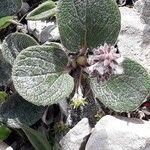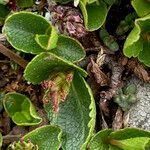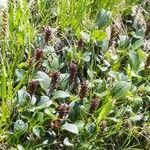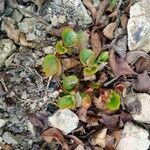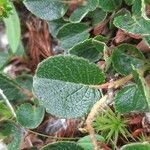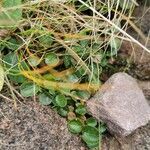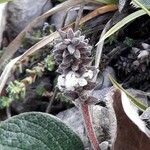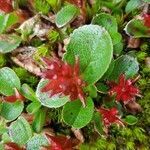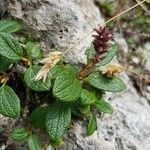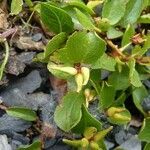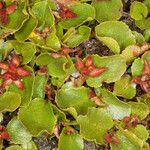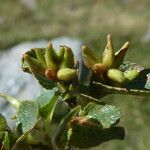Plants 0.005-0.05 m, (dwarf), forming clonal mats by rhizomes. Stems erect; branches red-brown to violet, (sometimes weakly glaucous), glabrous; branchlets yellow-brown or red-brown, glabrous. Leaves: stipules absent; petiole (convex or flat to deeply grooved adaxially), 1.5-6(-7) mm; largest medial blade (2 pairs of secondary veins arising at or close to base, arcing) circular, subcircular or broadly elliptic, 6-21(-34) × 6-17(-31) mm, 0.9-1.4 times as long as wide, base usually subcordate or cordate, sometimes convex or rounded, margins flat, crenulate or crenate, apex rounded, convex, retuse, or toothed, abaxial surface (not glaucous), glabrous, adaxial slightly glossy to almost dull, glabrous; proximal blade margins crenulate; juvenile blade glabrous. Catkins: from subterminal buds; staminate 3-7.5 × 1.5-5 mm, flowering branchlet 0.3-2 mm; pistillate loosely flowered (2-11 flowers), stout to globose, 3.3-13 × 2-10 mm, flowering branchlet 0.8-3.5 mm; floral bract tawny, light rose, or brown, 0.5-1.5 mm, margins ciliate, apex rounded, retuse, or truncate, entire, abaxially glabrous. Staminate flowers: abaxial nectary 0.5-0.8 mm, adaxial nectary oblong or ovate, 0.6-1.1 mm, nectaries distinct, or connate and shallowly cup-shaped; filaments distinct, glabrous, or hairy on proximal 1/2; anthers shortly cylindrical or globose, 0.3-0.6 mm. Pistillate flowers: abaxial nectary (0-)0.2-0.3 mm, adaxial nectary narrowly oblong or oblong, 0.3-1.1 mm, longer or shorter than stipe, nectaries distinct or connate and shallowly cup-shaped; stipe 0.3-1.1 mm; ovary pyriform or ovoid, glabrous, beak abruptly tapering to styles; ovules 11-18 per ovary; styles connate to distinct, 0.2-0.4 mm; stigmas broadly cylindrical or 2 plump lobes, 0.08-0.24-0.32 mm. Capsules 2.2-7.5 mm. 2n = 38.
More
Slender, subherbaceous plant, creeping in moss and humus, glabrous throughout, except the sometimes sparsely hairy scales; twigs chestnut, subascending; buds ovate, 1.5–2.5 mm; lvs oval to suborbicular or even wider than long, 1–3 × 1–2.5 cm, crenulate-dentate, green on both sides, reticulate beneath; catkins after the lvs, 10–17 mm, with 5–12(–16) fls, terminating short, 2–4-lvd twigs; scales light to dark brown; stamens 2, the filaments distinct; staminate fls biglandular; frs glabrous, subsessile, lanceolate, 3–6 mm; style 0.5 mm; 2n=38. Grassy, sandy, or rocky places; circumboreal, s. in N. Amer. to Mt. Katahdin, Me., Mt. Washington, N.H., and Essex Co., N.Y. June–Sept. A hybrid with no. 13 [Salix uva-ursi Pursh] has been called S. ×peasei Fernald.
Snowbeds and places with good snow protection, well-drained riverbanks, sandy beaches, granite boulder ridges, steep bouldery slopes, or in marshes, usually on non-calcareous substrates, places exposed to sea-spray; at elevations up to 1,700 metres.
